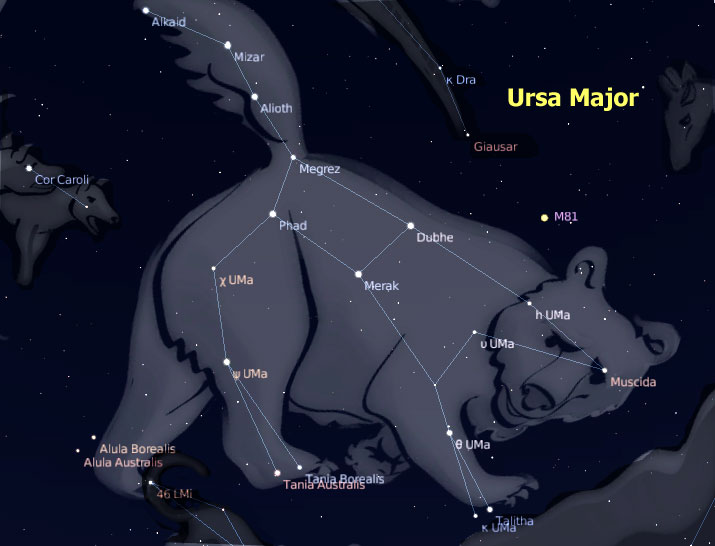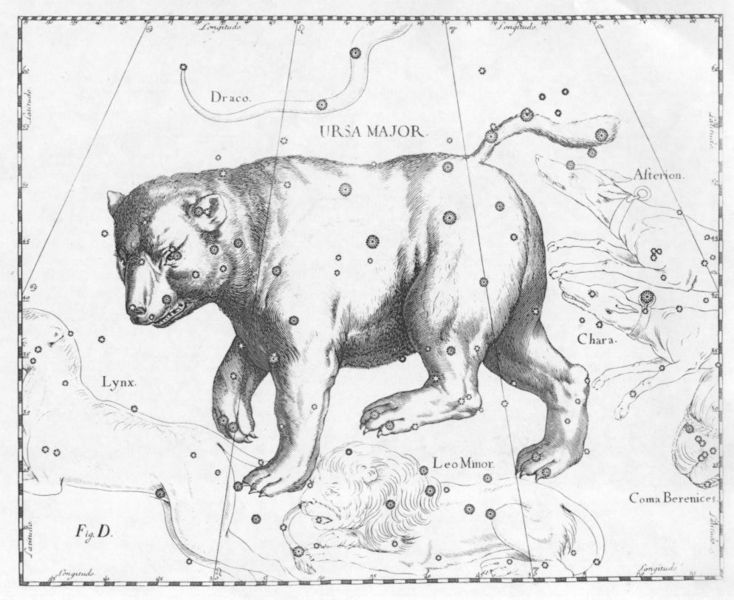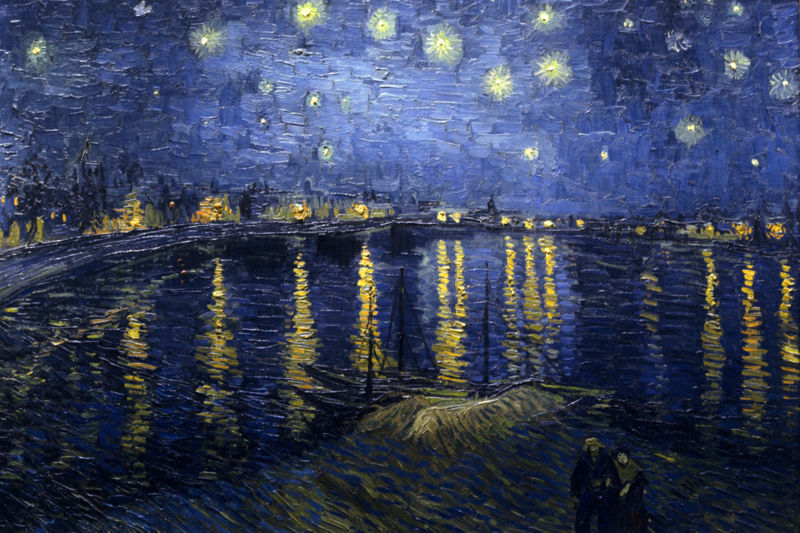Sky Notes Summer 2007 Previous Sky Notes
Links to objects and concepts discussed in this month's talk by Chris
Ursa Major (The Great Bear)

(image from Stellarium)
The seven brightest stars, located in the Bear's hindquarters and tail, form the well-known Big Dipper asterism. (In Britain, this asterism is known as the Plough.) Except for Dubhe and Alkaid, the stars of the Big Dipper all have proper motions heading towards a common point in Sagittarius. A few other such stars have been identified, and together they are called the Ursa Major Moving Group.In addition to the Big Dipper, another asterism comes from Arab culture — the "leaps of the gazelle", a series of three pairs of stars:
- ν and ξ Ursae Majoris, Alula Borealis and Australis, the "first leap";
- λ and μ Ursae Majoris, Tania Borealis and Australis, the "second leap";
- ι and κ Ursae Majoris, Talitha Borealis and Australis, the "third leap".
These stars are found along the southwest border of the constellation, the bear's toes.Mizar, a star in the Big Dipper, forms the famous visual double star with Alcor.W Ursae Majoris is the prototype of a class of contact binary variable stars, and ranges between 7.75m and 8.48m.47 Ursae Majoris has a planetary system with two confirmed planets, 2.54 times and 0.76 times the mass of Jupiter.Notable deep sky objectsSeveral bright galaxies are found in Ursa Major, including the pair Messier 81 (one of the brightest galaxies in the sky) and Messier 82 above the bear's head, and Pinwheel Galaxy (M101), a beautiful spiral northwest of η Ursae Majoris. The other notable spiral galaxies Messier 108 and Messier 109 may also be found in this constellation. Altogether, the constellation contains about 50 galaxies observable through amateur telescope. The bright planetary nebula Owl Nebula (M97), named for its appearance, can be found along the bottom of the bowl of the the Big Dipper. Of note as a curiosity more than an interesting deep sky object is Messier 40, a double star that Messier nonetheless included in his catalogue.The Hubble Deep Field is located to the northeast of δ Ursae Majoris.
Ursa Major was one of the 48 constellations listed by Ptolemy. It is one of the most widely-known constellations, having been mentioned by such poets as Homer, Spenser, Shakespeare, Tennyson and Bertrand Cantat. The Finnish epicKalevala mentions it, and Vincent Van Gogh painted it upsidedownMythologyThe constellation of Ursa Major has been seen by many distinct civilizations as a bear.[1] In one sequence, together with the nearby Ursa Minor, it is associated with the myth of Callisto, in another the myth of Cynosura.The origin of the name is a mistake founded on approximate sounds. Rakh is Sanskrit for "to be bright" the Greeks corrupted this to the word arktos which means bear. The Romans called it Ursa the bear, and Septemtriones the seven ploughing oxen which lead to Septentrional signifying the north.In earlier times, Greek mythology did not consider Ursa Major a bear, and instead its 3 bright stars (situated in the tail) were seen as apples growing on a tree (sometimes represented by the fainter stars in the remainder of the constellation). At the same time, the stars of Ursa Minor were associated with the Hesperides. These two groups of stars, together with Libra, Boötes and Draco, may have inspired the myth of the apples of the Hesperides, one of The Twelve Labours of Hercules. In Hindu mythology the seven stars are identified with seven sages and the constellation is called Saptarshi Mandalam.One of the few star groups mentioned in the Bible (Job 9:9; 38:32 — Orion and the Pleiades being others), Ursa Major was also pictured as a bear by both the Hebrews and most North American peoples. However, as bears do not have long tails, they considered Alioth, Mizar, and Alkaid to be either three cubs following their mother or three hunters. ("The Bear" was mistranslated as "Arcturus" in the Vulgate and the error persisted in the KJV. Later translations have corrected this.)The Iroquois Native Americans also interpreted Alioth, Mizar, and Alkaid as three hunters pursuing the Great Bear. According to one version of their myth, the first hunter (Alioth) is carrying a bow and arrow to strike down the bear. The second hunter (Mizar) carries a large pot on his shoulder in which to cook the bear while the third hunter (Alkaid) hauls a pile of firewood to light a fire beneath the pot.In Burmese, Pucwan Tārā (pronounced "bazun taja") is the name of a constellation comprising stars from the head and forelegs of Ursa Major; pucwan is a general term for prawn, shrimp, crab, lobster, etc.Graphic visualisation
Visualisation
 The drawing Hevelius made of Ursa Major. The drawing is made as if being viewed from outside the celestial sphere. The drawing Hevelius made of Ursa Major. The drawing is made as if being viewed from outside the celestial sphere.
 The constellation features prominently in van Gogh's painting "Starry Night Over the Rhone." Van Gogh placed it on the southern sky The constellation features prominently in van Gogh's painting "Starry Night Over the Rhone." Van Gogh placed it on the southern sky
(text and images credit: Wikipedia)
Download Stellarium www.stellarium.org
|

